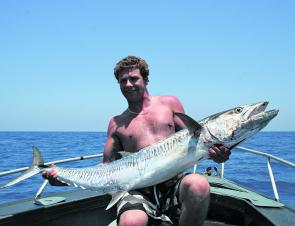A windy winter looks to be on the cards, if the start is anything to go by. The good news is that when the winds have backed off enough for boats to venture out, mackerel have been around in good numbers.
July is typified by extended periods of fresh to frightening southeasters, so when you get a chance to get out into the bluewater, make the most of it. The reality is that most angling will be done in the estuaries this month, unless we get a repeat of 2009 when there was a prolonged run of awesome weather. What we don’t want is a repeat of last year’s howling conditions!
When the wind allows, it won’t be only the mackerel on the chew; large-mouth nannygai and red emperor should also be turning it on in the deep water. Scoring bag limits of these species is not uncommon in July.
Mackerel will be the main target this month, and reaching the mackerel grounds is a bit easier than getting to the reef so the chances of scoring a trip are also better. Spanish, doggy and spotted mackerel have all been around early in the season, so it’s shaping up to be a bumper mackerel year. The southeasters are usually lighter and more southerly early in the morning, making it more viable to sneak out just before or on daylight and get in a couple of hours’ fishing before the winds get menacing again. The likes of the Russell and High islands to the south, the Cairns Inlet leads, off False Cape, Little Fitzroy Island, Double Island and the close wrecks are all possibilities for a lightening raid early in the morning.
The old faithful floating rig with a pilchard down about 3m, will generally do the job when the mackerel are on the chew. However, if they are a little more picky you may need to refine your plan of attack. Spanish mackerel can be fairly finicky at times but trolling is probably the best all-round approach for chasing these silver bullets. Deploying a trolled gar and hard-bodied lures with a good action at slow speed is a reliable broad brush approach. If you have the gar near the surface, combine it with a deep diving lure or vice versa. Wolf herring, hairtail, mullet, pike, baby barracuda, small bonito, scad, pilchards and grinner all make great trolling baits as well.
Most Spaniards will be in the 6-10kg range but if you are targeting a trophy fish, live baits like fusilier, hussar, pike, mullet, gar and any small trevally will see you in with a better chance.
Super slow trolling live baits is absolute dynamite on Spaniards. The old saying “you can catch elephants with peanuts” certainly applies to Spanish mackerel. Some of the best Spaniard fishing I have experienced has been when trolling live sardines less than 15cm long. Hook the sardine or mud herring using a towing hook in the clear gristle in front of the eye, and have a trailing hook swinging free, level with the tail. Anchoring the trailing hook through the body or tail of the sardine restricts its movement too much and it cannot remain swimming upright for very long. With just a single tow hook in the bait, it can swim enticingly for a considerable period, provided the boat speed is below walking pace.
Doggie mackerel should be around in good numbers close inshore, and while the old faithful pillie will do the job there is nothing better than live sardines or mud herring. Doggies respond well to berley, so if they are scattered you’ll find that a good berley trail will bring them to your boat more consistently.
Mackerel won’t be the only pelagics around this month. Cobia, cracking GTs, yellowfin tuna and the odd early baby black marlin can all appear on the radar. All up, July is a great month for the light gear sportfisher when the weather gods cooperate.
The reef fishing can be awesome in July and it’s a matter of clearing the schedule to take advantage of any drop in the wind. Often the calm periods will be short lived, as one high pressure fades away before being replaced by yet another. The most frustrating part is these flat periods seldom align with weekends, so they can only be taken advantage of by anglers lucky enough to have flexible work conditions. The deep water is the go, with overnighters the best option, although they’re not the only way to tag a red. Red emperor and large-mouth nannygai to 10kg are not uncommon and they are often found schooling so be ready for a real workout if you strike them on the chew.
The back-to-earth reality of July is that most times the only fishable locations are tucked away up a small mangrove creek, out of the howling winds. If this is where you find yourself there will still be plenty on offer, with giant trevally, golden trevally and big queenfish for the thrill seekers, while bream, grunter, flathead and cod will be around for those chasing a feed. The rising tide will generally be more productive. If the water is filthy near the mouth due to the rough seas, try a little further upstream.
There will still be the odd barra, jack and fingermark around for those willing to put in the time and effort. Fishing in heavy cover with live prawns or small baitfish will be the best approach, along with a good dose of patience. Those prepared to put in the hard yards can also turn up a feed of mud crabs. Here’s hoping for a balmy July to make up for the miserable start to winter!
Reads: 1184
Spanish mackerel like this beauty can be finicky at times but trolling is probably the best all-round approach for chasing these silver bullets.




